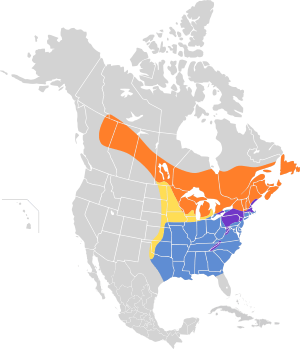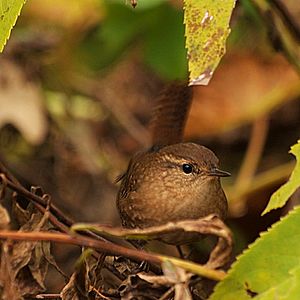Winter wren facts for kids
Quick facts for kids Winter wren |
|
|---|---|
 |
|
| In Central Park, New York. | |
| Conservation status | |
| Scientific classification | |
| Genus: |
Troglodytes
|
| Species: |
hiemalis
|
 |
|
| Synonyms | |
|
Olbiorchilus hiemalis |
|
The winter wren (Troglodytes hiemalis) is a tiny North American bird. It belongs to the wren family, called Troglodytidae. This family is mostly found in the New World.
Winter wrens used to be grouped with two other types of wrens. These were the Pacific wren from western North America and the Eurasian wren from Eurasia. Now, scientists consider them separate species.
These small birds build their nests in coniferous forests. You can find them from British Columbia all the way to the Atlantic Ocean. When winter comes, they fly south. They spend the colder months in southeastern Canada, the eastern United States, and sometimes in northeastern Mexico.
The scientific name, Troglodytes hiemalis, comes from Greek words. "Troglodytes" means "cave-dweller." This name fits because the wren likes to hide in small spaces. It creeps into holes or cracks when looking for arthropods (like insects and spiders) or when it's time to sleep.
Contents
About the Winter Wren
The winter wren is a very small bird. Its short tail often sticks up over its back. Its short neck makes it look like a tiny brown ball.
Its feathers are reddish-brown on top and grayer underneath. It has darker brown and gray stripes on its body, wings, and tail. The bill is dark brown, and its legs are pale brown. Young wrens have less clear stripes. Most winter wrens are easy to spot because of the light-colored "eyebrows" above their eyes.
Winter Wren Measurements
- Length: 3.1 to 4.7 inches (8 to 12 cm)
- Weight: 0.3 to 0.4 ounces (8 to 12 grams)
- Wingspan: 4.7 to 6.3 inches (12 to 16 cm)
Winter Wren Habits

Winter wrens mostly live in coniferous forests. They especially like forests with spruce and fir trees. You can often hear their long, cheerful song in these areas.
Even though they eat mostly insects, they can stay in cold, snowy places. They find insects by searching on tree bark and fallen logs.
These birds are always moving. They creep and climb without stopping. Their short flights are fast and direct, but they don't fly long distances. Their tiny round wings whir as they fly from one bush to another.
At night, especially in winter, they often sleep in hidden spots. These can be snug holes or even old nests. When the weather is very cold, many wrens might gather together. They do this to keep warm, sometimes with their family or with other wrens.
Their main food is insects and spiders. In winter, they might also eat large pupae (insect cocoons) and some seeds.
Winter Wren Reproduction
The male winter wren builds several small nests. These are sometimes called "cock nests." The female then chooses one of these nests. She will line it with soft materials before laying her eggs.
The nest is usually round and made of grass, moss, lichens, or leaves. Wrens often tuck their nests into holes. These can be in a wall, a tree trunk, a crack in a rock, or a corner of a building. Sometimes they build nests in bushes or in branches where floodwaters have left debris.
Females lay five to eight white or slightly speckled eggs in April. They can also raise a second group of chicks later in the season.
See also
 In Spanish: Chochín hiemal para niños
In Spanish: Chochín hiemal para niños


